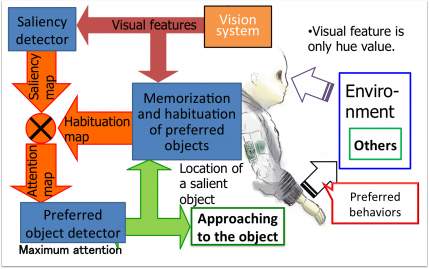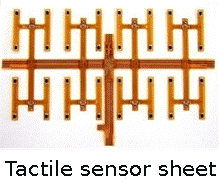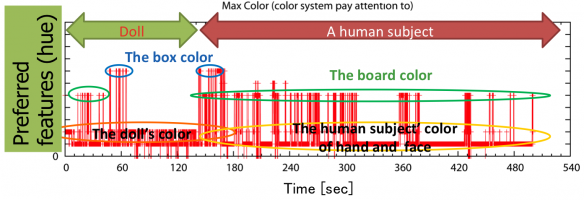Noby (Baby robot).
Whole body humanoid robot for motor learning and cognitive development
Design concept and construction
We have developed the humanoid robot under the basic policy that it has 9 months old body parameters, soft skin and tactile sensors, and can interact with environment and human frequently.
The implementation of soft tactile skin had tried some times by ourselves, however we had not experienced to implement soft tactile skin on whole body shells which are soft and has big curvature. Also there had never been a research to try it in the world.
First of all, we developed a prototype robot which has 770 mm tall, 4 kg weight, 19 DOF, and is actuated by general servo motors, to learn the implementation of the skin and joint interference. We confirm that by the robot specs have no problem to execute baby related behaviors including crawling and rolling over by this prototype, and the tactile skin system has sufficient ability to detect tactile data to discriminate holding, crawling, or rolling over.
Finally, we designed and constructed the new humanoid baby robot based on the above knowledge. We call the robot as Noby. Noby is abbreviated from Nine-months-Old BbaY.

Fig.2 Prototype baby robot for basic designe

Fig.3 An example of tactile data.
|
Height
|
750mm |
|---|---|
|
Weight
|
9kg |
|
Mechanics
|
Antagonistic actuator |
|
Number of Motors
|
32 |
|
Number of Joints
|
30 |
|
Vision
|
2 cameras in the eyes |
|
Auditory
|
2 microphones in the ears |
|
Tactile sensor
|
Light diffusion (About 750 points) |
|
Voice
|
1 Speaker in the mouse |

Fig.6 Whole body tactile sensor for the baby robot
Fig.7 Noby
This whole body humanoid robot for motor learning and cognitive development resembles 9 months old baby very well ever seen before.
We have used Noby for experiments of cognitive developmental models.
Finding object’s affordance and exploit the affordance.
We studied a exploring and leaning model of finding objects’ affordance and exploit the affordance. There seem to be various number of feature in objects to generate salient responses. Infant find and repeat the behavior within the objects. For example, infants make noise when they handle a rattle or a castanet. To acquire this kind of object related behavior, we constructed a probabilistic behavior generation and learning model extracting salient features from a object. We conducted experiment with rattle and castanet, keyboard (Fig.8). As the result, the robot acquired various object related behaviors representing object features. The entropy of the behaviors decrease along with time, that is, the robot acquired a specific movement (Fig.9).

Fig.8 Noby acquired a behavior to generate noise from a rattle.

Fig.9 The entropy of the learning with a rattle. The value decrease because the behavior which generates noise well increase.
Interest model
Infants explore environments, have a interest to a certain object. They grasp, push, hit, lick, throw the object, and try to communicate to others with joint attention to the object. We constructed an interest model to resemble such infants’ feature. The model consists of the saliency map generating bottom up visual attention and a habituation model. The model can generate interest point on vision and the point transfer to other interest points by basic experiments. The interest point move traumatically when the model is embedded to Noby and It reach to interest points. Because the Noby’s behaviors change the environment and the environment generate different interests. Finally, Noby with the interest model interacted with human subjects. In the interaction, the human subject change behavior to get Noby’s interest and the interaction between the two generates complex interplay. This result indicates that interest change contribute to get social ability.

Fig.10 Robotic interest model from bottom up visual saliency.







